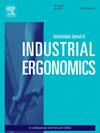颈部僵硬和酸痛健康教育混合现实系统的开发和评价
IF 3
2区 工程技术
Q2 ENGINEERING, INDUSTRIAL
International Journal of Industrial Ergonomics
Pub Date : 2025-08-06
DOI:10.1016/j.ergon.2025.103779
引用次数: 0
摘要
手机在日常生活中是不可或缺的,尤其是对大学生来说,但长时间使用手机会导致颈部僵硬和酸痛等姿势问题,这些问题可能反映出更严重的潜在健康问题。同时,护理人员的全球短缺正在挑战医疗保健系统,强调需要创新的教育工具,减轻护理专业人员的工作量。本研究开发并评估了一种使用微软HoloLens提供颈部健康教育的混合现实(MR)系统。通过主观尺度和定性反馈来评估系统的可用性和用户满意度,以确定其与传统教材相比的有效性。20名参与者被随机分为两组:基于mr的HoloLens组和传统的传单组(每组10名参与者)。两组接受相同的颈部僵硬和疼痛健康教育内容。参与者完成了9项知识测试和半结构化访谈,以评估理解并帮助收集系统可用性反馈。HoloLens小组使用系统可用性量表(SUS)和用户交互满意度问卷(QUIS)进一步评估系统。虽然两组之间的知识获取得分相当,但HoloLens组表现出明显更高的参与度和更强的继续接受健康教育的意愿。MR系统的SUS平均得分为76分,表示“良好”可用性,评级为B级。QUIS的反应表明,跨可用性结构的满意度很高。定性反馈突出了HoloLens系统的沉浸式和交互式设计,通过将教育内容与个人相关性和好奇心联系起来,促进了用户的参与和激励。这些发现表明磁共振成像技术有潜力通过弥合静态信息传递和动态学习者参与之间的差距来改变健康教育,最终支持提高对健康主题的理解和持续兴趣。本文章由计算机程序翻译,如有差异,请以英文原文为准。
Development and evaluation of a mixed reality system for health education on neck stiffness and soreness
Mobile phones are indispensable in daily life, especially among university students, yet their prolonged use has been linked to postural problems such as neck stiffness and soreness - conditions that may reflect more serious underlying health issues. Concurrently, a global shortage of nursing personnel is challenging healthcare systems, emphasizing the need for innovative educational tools that alleviate the workload of nursing professionals. This research develops and evaluates a mixed-reality (MR) system using Microsoft HoloLens to offer health education on neck health. The system's usability and user satisfaction are assessed through subjective scales and qualitative feedback to determine its effectiveness versus traditional educational materials.
Twenty participants were randomly assigned to two groups: an MR-based HoloLens group and a traditional leaflet group (10 participants each). Both groups received identical health education content on neck stiffness and soreness. Participants completed a 9-item knowledge test and semi-structured interviews to assess comprehension and to help gather system usability feedback. The HoloLens group further evaluated the system using the System Usability Scale (SUS) and the Questionnaire for User Interaction Satisfaction (QUIS).
While knowledge acquisition scores are comparable between the groups, the HoloLens group exhibits significantly higher levels of engagement and stronger intent to pursue further health education. The MR system obtains a mean SUS score of 76, denoting “Good” usability and a grade B rating. QUIS responses indicate high satisfaction levels across usability constructs. Qualitative feedback highlights the immersive and interactive design of the HoloLens system, which fosters engagement and motivates users by connecting educational content to personal relevance and curiosity. These findings demonstrate the potential of MR technologies to transform health education by bridging the gap between static information delivery and dynamic learner engagement, ultimately supporting improved comprehension and sustained interest in health topics.
求助全文
通过发布文献求助,成功后即可免费获取论文全文。
去求助
来源期刊
CiteScore
6.40
自引率
12.90%
发文量
110
审稿时长
56 days
期刊介绍:
The journal publishes original contributions that add to our understanding of the role of humans in today systems and the interactions thereof with various system components. The journal typically covers the following areas: industrial and occupational ergonomics, design of systems, tools and equipment, human performance measurement and modeling, human productivity, humans in technologically complex systems, and safety. The focus of the articles includes basic theoretical advances, applications, case studies, new methodologies and procedures; and empirical studies.

 求助内容:
求助内容: 应助结果提醒方式:
应助结果提醒方式:


